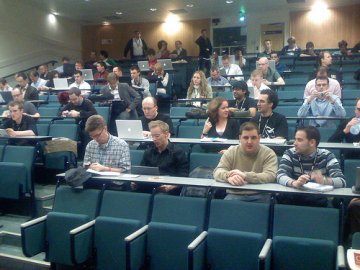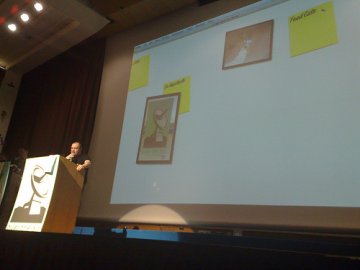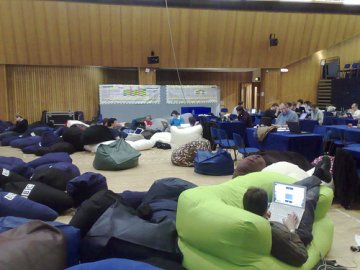 This past weekend saw a gathering of mobile developers, manufacturers and network operators at London’s Imperial College for Over The Air, a two day event to promote development for mobile devices. With speakers from Nokia, Google, Vodafone, Adobe, Sun, Yahoo and more, there were a lot of brains in the room. And this was a genuine cross-platform gig, with Symbian, Windows Mobile, Widgets, J2ME and other environments all getting a good crack of the whip.
This past weekend saw a gathering of mobile developers, manufacturers and network operators at London’s Imperial College for Over The Air, a two day event to promote development for mobile devices. With speakers from Nokia, Google, Vodafone, Adobe, Sun, Yahoo and more, there were a lot of brains in the room. And this was a genuine cross-platform gig, with Symbian, Windows Mobile, Widgets, J2ME and other environments all getting a good crack of the whip.
Friday, the first day, saw the majority of sessions on mobile development, from user interface seminars, to new project ideas. But what was getting the most attention were the sessions talking about new APIs for the networks and portals, allowing people to get access to uniquely mobile data for their applications. And normally, that would be it – but Over the Air, following on from the Hackday and Barcamp ethos, didn’t stop when the sun set.
Through the night, and then through Saturday, teams of hackers and programmers took all they had learned, made use of the very big data pipe Imperial College had hooked up to the Wi-Fi, and started coding new mobile applications to follow up what had been presented that day. While you could bring in a pre-rolled project to present (and by my reckoning at least two early stage start-ups did exactly that), the majority of projects were either thought up previously but started on the day, or had been sparked by discussion around the room. And on the strength of the 21 projects that were demonstrated on Saturday afternoon, the creative juices for the mobile space are still running well, exploring and coming up with some wonderful ideas. I want to highlight four of the projects, which I hope will continue to receive attention and get into as many phones as possible.
And on the strength of the 21 projects that were demonstrated on Saturday afternoon, the creative juices for the mobile space are still running well, exploring and coming up with some wonderful ideas. I want to highlight four of the projects, which I hope will continue to receive attention and get into as many phones as possible.
21CFD (More on the Over the Air blog)
First up is 21CFD, the 21st Century Fridge Door. This has to be the cutest idea I’ve seen for a mobile device in a long time, and while it naturally riffs on the oft-quoted internet meme of ‘what would happen if your fridge was on the internet?’ it does answer the question in a human way. The premise is simple, that the door of your fridge is a display, and the display has an email address and mobile phone number. From your handset, you can stick notes onto the fridge door, send pictures, upload media, and have them automaticall 'stuck' on the fridge screen - where you can maipulate, move or delete them as required.
You can view the prototype fridge display at http://www.21cfd.com/. Practical and simple, and hides a huge amount of coding and complexity behind the description, 21CFD is a project I could see a network happily adopting if they could sort out a deal with a flat screen monitor giveaway for new sign-ups to the network.
Autowigificationizor (More on the Over the Air blog)
Owen Griffin’s clumsily titled, but genuinely useful Autowigificationizor button for Firefox users again leverages something complicated (taking a web site on your desktop and putting it onto your mobile) and turns it into a straightforward process. Once you hit the button in Firefox, the current web site you are browsing is turned into an S60 widget, and you’ll be sent a URL to download it via SMS so it appears on your handset as if it was a regular program. Naturally it’s powered by the original site's RSS feed, with help from Vodafone’s Betavine toolkit for the handset delivery mechanism. Capture The Flag (More on the Over the Air blog)
Capture The Flag (More on the Over the Air blog)
An early prototype of what could be a new genre of gaming. Location Based Gaming, using the built in GPS of a handset or (I suspect more commonly in the future) the CellID of a network, can be used to bring gaming into the physical world. It was this that saw Simon Maddux and his team take to the streets of central London at 2 am in the morning to first lay out, and then play a massive game of ‘capture the flag.’ The twist being that the flags weren’t actually physical, but only resided as a location in a central server, that also knew where all the players were. The more flags you could find and capture, the better your score. Nicely innovative, and I can imagine the fun that team building exercises and real world reality games would be with this. Hmm, perhaps there’s a Channel 5 game show in this... [hey, they'll be looking for a charismatic presenter, Ewan! - Ed]
Phone Fight (More on the Over the Air blog)
I can’t let this summary go by without mentioning Phone Fight, from the travel group LastMinute.com’s research lab. You all know the reaction that the accelerometer based light saber application gets on S60 devices. Now imagine taking that, pairing up one phone to another, and using them in one-on-one combat in some sort of mystic rotation-based scissors-paper-stone game as you face your opponent. Silly, crazy, yet horribly addictive… if only one application was to get a public release after Over the Air, I’d be looking for this one!
Summary
Over the Air perhaps shows that any worries of mobile development stagnating are just that. Worries. While the standalone application seems to be consigned to history (even games are getting in on the act, with interfaces to real world, connected game play, and massive multiplayer extravaganzas), the inventiveness of the programmers now that the networks are more inclined to release data and tools knows very little bounds in ways that these portable computers can interface to desktops, the internet, and our personal lives. Although it should be noted that the lack of Geo-Data meant that some of the location based services teams had to go out and map the latitude and longitude coordinates themselves before they could start playing.
The mobile development scene in the UK is certainly healthy!
-- Ewan Spence, April 2008
PS. Oh and if you’re wondering what I got up to, no I didn’t code anything. A group of us decided we needed to film the last episode of Torchwood for the BBC, the results of which can be seen below
